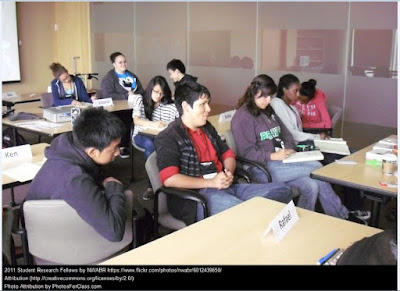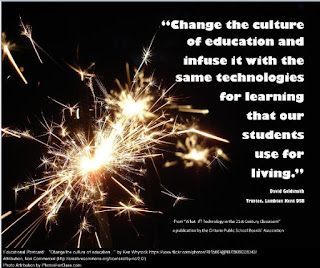S.O.S: Spotlight on Strategies
Let's take a look at a simple strategy that can be easily
implemented across any curricular area to increase student engagement in the
classroom; Fan-N-Pick. One of the great things about this strategy, like many of the other
Kagan Structures (strategies), is that all students must have an active role during the use
of the strategy. Unlike traditional instruction where the teacher asks a
question which is answered by only one or two students while the rest of the
class sits passively, this strategy engages all learners. Students do not have the chance to “hide” in the crowd
because each student has a role in the activity.
Retrieved from YouTube: What is Kagan?
This strategy also supports collaboration between students as they have to work in a group and each student must complete their role in the group. Additionally, the roles rotate so that all students have an opportunity to complete each part. Collaboration (team work) is an important soft skill for students to master in school as it is an essential skill they will need upon entering the working world. Students must learn how to work together to achieve an end goal through collaboration. They must also work together to problem solve and resolve group conflict or disagreements. As students work through the Fan-N-Pick activity, they are able to practice these skills.
Fan-N-Pick also involves a component of paraphrasing,
restating, checking and offering praise in the final role. These are also
skills that students often struggle with. Paraphrasing and restating are
important skills because if someone is able to restate or put someone else’s
ideas in their own words, it demonstrates they truly understand what was
stated. This role also asks the student to “check” or make sure the student
answered the question correctly. This gives another opportunity for students to
not only demonstrate their own understanding, but also provide effective
feedback and constructive criticism to their peers. This is a skill that should
be implicitly taught, modeled and practiced in the classroom. Many students do
not know how to correct others in a respectful and constructive way. This
strategy allows students to practice this skill. It also helps students move
beyond “Good job” or “nice work” to give valuable feedback.
Additional Kagan Strategies
Naccio, J. (2007). Structures at a glance. Retrieved on July 25, 2015 from http://www.sisd.net/cms/lib/TX01001452/Centricity/Domain/1759/Kagan-Structures2.ppt
Integrating
digital media can make the use of this strategy even more valuable in the
classroom. Following the Fan-N-Pick activity the students could create a blog
post or discussion thread about a particular question or the activity as a
whole to which other students could respond. This would give students a way to
use the content again in a new method which will help them develop deeper
understanding of the concepts. Students could also make a movie of the
Fan-N-Pick process as documentation of their participation, or as a training
video for other students that will be doing the activity. They could create a
video demonstrating effective and ineffective feedback and constructive criticism
for other students. Students could also create an online discussion board so
they could see how other groups answered the questions or what discussions
developed with other groups.
Using digital media and web tools to support this strategy will help students develop deeper understanding of the topic for the activity. Integrating digital media also gives the students the opportunity to be creative in how they demonstrate their understanding. Providing students with activities that foster creativity is an important role for the classroom teacher to transform our classrooms into places where students become active, engaged learners that assume responsibility for their own knowledge and understanding, rather than memorize and repeat random information from the teacher. By transforming our classrooms into spaces that truly foster learning, creativity and active student participation, we will be well on the road to helping our students prepare for success beyond their school careers.
Credits:
Kagan, S. & Kagan, M. (2009) Kagan sooperative learning. San Clemente, CA: Kagan Publishing.
Kagan, S. (2009). Description of strategies [PDF document}. Retrieved from
http://www.psd150.org//cms/lib2/IL01001530/Centricity/Domain/23/DescriptionsOfStrategies.pdf
Naccio, J. (2007). Structures at a glance [Power Point slides}. Retrieved from
http://www.sisd.net/cms/lib/TX01001452/Centricity/Domain/1759/Kagan-Structures2.ppt
Oberpeul, Hillary. The "soft skills" that will land you your dream job. Retrieved from
https://grad.uc.edu/student-life/news/soft-skills.html.
What is Kagan. (2014). Retrieved July, 25, 2015 from https://youtu.be/D-yzgJtgVrg.






















